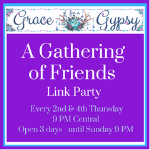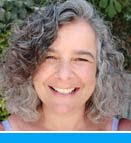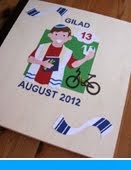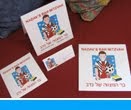I've blogged about
Be'ersheva before. Mister Handmade in Israel and I made an impromptu visit there back in 2016. This time I took my dad. Be'ersheva is a very old city, having been in existence for more than 6,000 years, though the city as we know it today is relatively new and was only established at the beginning of the 20th century under the Ottoman Turkish rule. There were a few places I wanted to show Dad in Be'ersheva's Old City, which still retains many of its historic Ottoman buildings and buildings built during the British rule. We started with the ANZAC (Australian and New Zealand Army Corps) Memorial Centre.
The ANZAC Memorial Centre, which was dedicated on the 100th anniversary of the liberation of Be'ersheva in 2017, stands adjacent to the Commonwealth War Graves Cemetery in Be'ersheva. The centre tells the story of the
ANZAC conquest of Be'ersheva and puts the visitor in the shoes of the young soldiers who fought there 100 years ago, thousands of kilometres away from home.
The ANZAC was a military force of Australian and New Zealand soldiers under the command of the British, who fought in the First World War in the Middle East, including the liberation of Be'ersheva from Ottoman rule. Though the ANZAC cavalry had never trained for such an assault,
Lt. Gen. Harry Chauvel, who led the ANZAC forces to victory, ordered his forces to charge the Ottoman forces fortified in trenches. They galloped so fast that the Ottoman marksmen couldn’t adjust their range quickly enough to effectively aim at the advancing cavalry. After crossing the plain, the soldiers dismounted and fought the Ottomans hand to hand in the trenches. By nightfall of 31st October 1917, Be'ersheva was under British control.
Our guided visit to the centre was an informative and moving experience. We learnt about the ANZAC horsemen and the historical developments of the First World War in the Land of Israel. The centre contains archaic items, testimonies from the Battle of Be'ersheva, personal diaries of the famous cavalry that participated in the battles, historical findings and more. The impressive viewing point of the Commonwealth War Graves Cemetery very much added to the whole experience.
The Old City of Be'ersheva is currently being transformed into a hub of tourism and culture and, as the development progresses, the area is becoming a cool place to hang out. The Be'ersheva municipality has begun to develop and maintain the streets, and in addition, many of the historic buildings in the area have signs posted by the Council for Conservation of Heritage Sites, making it easier for visitors to the city.
My dad and I stayed at
The Ottoman House, gorgeous boutique holiday apartments located in the heart of the Old City and we enjoyed a delicious vegan meal in a lovely cafe located on one the newly renovated pedestrianised streets. The beautifully styled apartments of The Ottoman House, so different from the surrounding rundown area, were a great choice. I have high hopes for tourism in Be'ersheva!
The following morning we took a walk around the Old City, stopping at Allenby Park, named after the English General
Edmund Allenby. The park that was constructed in 1902 included trees, an orchard and garden shrubs, and it served as a leisure site for those who came to the Ottoman government building in the city. The park was constructed without a surrounding wall, and within a short time it was destroyed by animals, such as goats and sheep, which ate the vegetation.
In 1915 the park was restored by the Ottoman military governor,
Djemal Pasha. Trees and shrubs were planted in order to create a pretty, green area. In the middle of the park, a marble column was erected, which was engraved with an inscription lauding the victory of the Ottoman Empire.
After Be'ersheva was conquered by the British, the new rulers installed a statue of General Allenby, who had conquered the area from the Ottomans. During riots that began in 1938, Arabs shattered the statue and the British decided not to restore the image of the general on the column. In recent years a statue of the legendary General was restored in the park at a ceremony attended by his relatives. Work will soon begin on rehabilitating Allenby Park, which has been somewhat neglected, in order to restore it to its original state from about a hundred years ago.
Our next stop, and a return visit for me, was at Abraham's Well International Visitor Centre. According to the bible, the story in Genesis 21 tells of a well which
Abraham dug and
Abimelech's servants seized. Abraham gave seven lambs to Abimelech as witness that he dug the well himself. Abimelech accepted the lambs and the two men swore an oath in the place named Be'ersheva. In 1838 the well was identified by the American biblical scholar
Edward Robinson and in 1897 a local sheikh built a modern structure above it. To this day many believe that this well is the well that was dug by Abraham and provided the name for the city of Be'ersheva (
Be'ersheva means "Well of Seven" or "Well of the Oath").
The new centre, designed as a tent, showcases the life of Abraham, the spiritual father of three
monotheistic religions. The well is in the centre of the courtyard. It is 3 metres in diameter and 26 metres deep. The top part of the well is lined with stones, probably from the
Byzantine period, and the bottom part is cut into the bedrock.
When Egyptian President
Anwar Sadat visited Be'ersheva with Prime Minister
Menachem Begin more than 40 years ago, he wanted to visit Abraham's Well, the site where a peace treaty had been signed between Abraham and the Philistine King Abimelech thousands of years ago.
Our last stop of the day was also a place I had visited before but I was so blown away by the design back then, I wanted to see if dad shared my thoughts.
The Monument to the Negev Brigade, known locally as the
Andarta, is situated on a mountain top north of the city. Designed by sculptor Dani Karavan and built between 1963 and 1968, the memorial's futuristic sculptures symbolise the sacrifice of 324 soldiers of the Palmach Negev Brigade who died defending the region against advancing Egyptian forces during the War of Independence.
The memorial, which has won many architectural awards, is made up of 18 raw concrete objects that symbolise and reflect the events of the War of Independence and of the Palmach. The perforated tower alludes to a watchtower shelled with gunfire and the pipeline tunnel is reminiscent of the channel of water in the Negev defended by the soldiers. Engraved in the concrete are the names of the soldiers who died in the war, the badge of the Palmach, diary passages from the soldiers, the battle registry, verses and songs.
Though the memorial does need a bit of tender loving care, the place is very moving and architecturally very interesting. Walking over and through the sculpture really gives you time to reflect on the events that occurred there over 70 years ago and to appreciate the now quiet beauty of the desert.


















































































